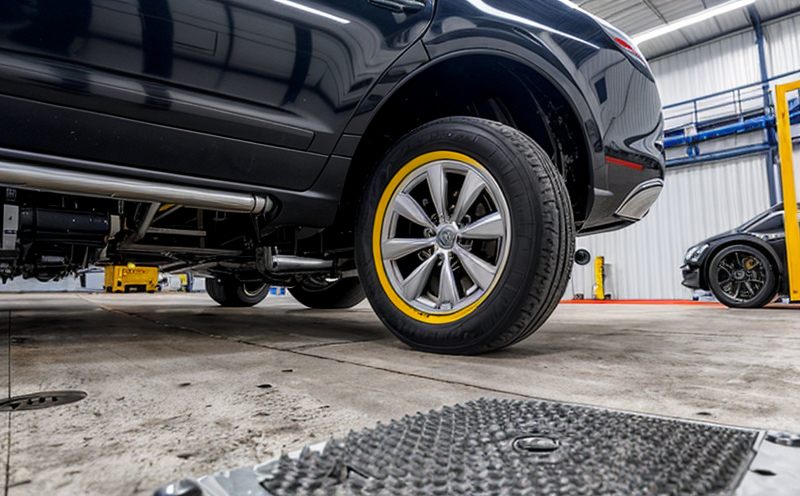SAE J328 Impact Testing of AM Automotive Wheels and Rims
The SAE J328 impact testing protocol is a critical standard in ensuring the durability and safety of additively manufactured (AM) automotive wheels and rims. This procedure evaluates how these components withstand high-impact forces, which are common in real-world driving conditions. The test aims to identify any potential weaknesses or defects that could compromise structural integrity under stress.
The testing process involves subjecting the AM wheel or rim to a controlled impact using a pendulum or drop-weight machine. The specimen is typically positioned so that it simulates the loading conditions expected during normal vehicle operation, including sudden stops or collisions with obstacles. The impact energy can be adjusted based on specific requirements but generally targets values within the range of 10-50 joules.
Proper preparation of the AM components before testing is crucial for accurate results. Specimens must be free from any surface defects such as cracks, porosity, or inclusions that could affect test outcomes. The geometry and dimensions should closely match those of production parts to ensure realistic simulation of real-world conditions. Post-test analysis focuses on measuring deformation levels, fracture patterns, and residual stresses.
The SAE J328 standard emphasizes the importance of accurate instrumentation and equipment calibration for consistent results across multiple tests. High-precision sensors are used to measure displacement, force, acceleration, and angular velocity during impact events. These data points help in understanding the dynamic response of the material under stress conditions. Additionally, non-destructive testing techniques like ultrasonic examination or radiography may be employed post-test to inspect for internal flaws that could have been introduced during manufacturing or impact.
Compliance with SAE J328 is essential for automotive manufacturers seeking certification or regulatory approval in various markets around the world. It ensures that AM components meet stringent quality standards and can perform reliably under expected operational loads. For companies focused on innovation within this rapidly evolving field, adherence to such standards provides a competitive edge by demonstrating commitment to safety and performance excellence.
Real-world applications highlight why SAE J328 testing is indispensable. In the automotive industry, where reliability and longevity are paramount, ensuring that AM wheels and rims pass impact tests helps reduce warranty claims and enhances brand reputation. Furthermore, compliance with this standard facilitates smoother integration of new technologies into existing supply chains without compromising safety standards.
It’s important to note that while SAE J328 provides comprehensive guidelines for conducting impact tests on AM automotive components, continuous advancements in additive manufacturing processes require regular updates to testing protocols. Collaboration between industry stakeholders and regulatory bodies ensures that these standards remain relevant and effective in addressing emerging challenges in the field.
Why It Matters
The significance of SAE J328 impact testing cannot be overstated when it comes to additively manufactured automotive components. By rigorously assessing how these parts handle high-impact forces, manufacturers can identify any weaknesses early on in the development process. This proactive approach not only enhances product safety but also contributes significantly towards reducing recalls and associated costs.
From a broader perspective, compliance with this standard fosters trust among consumers who value reliability above all else when selecting vehicles equipped with advanced AM technologies. Moreover, adherence to globally recognized testing protocols like SAE J328 opens doors for international market access, making it easier for companies to expand their reach beyond domestic borders.
For those involved in research and development (R&D), following established standards such as SAE J328 provides a solid foundation upon which further innovations can be built. The structured nature of these protocols allows for consistent evaluation across different iterations of AM processes, facilitating comparisons between various approaches and materials.
Benefits
The primary benefit of SAE J328 impact testing lies in its ability to enhance the overall quality and safety of additively manufactured automotive wheels and rims. Through systematic evaluation under controlled conditions, manufacturers gain valuable insights into potential areas needing improvement before mass production begins. This translates directly into improved product reliability, lower failure rates, and enhanced customer satisfaction.
Another key advantage is the increased confidence among regulatory bodies regarding the suitability of AM components for use in vehicles. When products meet stringent testing requirements like those outlined by SAE J328, they are more likely to receive favorable reviews during approval processes. This not only simplifies compliance efforts but also accelerates time-to-market strategies.
For procurement teams, ensuring that suppliers comply with such rigorous standards ensures consistent delivery of high-quality materials and parts. It eliminates the risk associated with subpar products potentially disrupting production schedules or compromising final assembly quality.
International Acceptance and Recognition
- The SAE J328 impact testing protocol is widely accepted across multiple international standards bodies, including ISO and ASTM. Compliance ensures seamless integration into global supply chains.
- Countries such as the United States, Canada, Europe (via ECE-R149), Japan, and China have recognized this standard for its contribution to automotive safety and performance.
Manufacturers who adhere to SAE J328 not only meet local requirements but also open up opportunities for exports. By aligning with these globally accepted practices, companies demonstrate their commitment to quality and safety standards that resonate universally.





